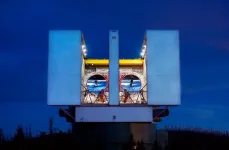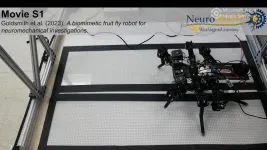Team develops all-species coronavirus test
2023-07-06
(Press-News.org) CHAMPAIGN, Ill. — In an advance that will help scientists track coronavirus variants in wild and domesticated animals, researchers report they can now detect exposure to the SARS-CoV-2 virus in any animal species. Most coronavirus antibody tests require specialized chemical reagents to detect host antibody responses against the virus in each species tested, impeding research across species.
The virus that causes COVID-19 in humans also infects a variety of animals, said University of Illinois Urbana-Champaign pathobiology professor and virologist Ying Fang, who led the new research. So far, the virus has been detected in cats, dogs, rodents, deer, apes and a variety of farm and zoo animals. The virus also mutates in these hosts, potentially leading to new variants that can endanger their – and human – health.
“Highly sensitive and specific diagnostic reagents and assays are urgently needed for rapid detection and implementation of strategies for prevention and control of the infection in animals,” the researchers wrote in the journal mSphere, where their findings are reported.
The new coronavirus test focuses on antibodies against a protein, called the N-protein, that is embedded in the virus’s nucleocapsid – a structure made up of proteins and nucleic acids contained within a viral membrane. The N-protein makes a better target than the membrane-bound viral proteins that are usually used in tests for antibody responses, Fang said.
“The N-protein is more abundant and it is more conserved than the proteins used in most tests,” she said. This means that the structure of the protein is more consistent across species, making it a good target for all-species antibody tests.
The team used an N-protein-based blocking ELISA protocol for their test. This method involves coating an ELISA plate with the N-protein, then adding a serum sample of whatever animal is being tested. If the animal has been infected with the coronavirus, its serum will contain anti-N-protein antibodies, which will bind to the N-protein-coated plate. The scientists then wash the plate and add a secondary biotin-tagged monoclonal antibody that targets the N-protein. If the animal is positive for coronavirus infection, its antibodies will block the secondary antibodies from binding to the N-protein. If the animal has not been infected, the monoclonal antibodies will attach to the coated plate and generate a color signal when specific chemicals are added to the plate.
The researchers validated their test using samples from various animals with known SARS-CoV-2 infection status, finding the tests had more than 97% sensitivity and 98% specificity. Further tests in domestic cats showed that the assay was able to detect infection within seven days of exposure to the virus.
The development of accurate cross-species coronavirus tests provides a useful tool for SARS-CoV-2 field surveillance in animal populations, helping scientists identify potential new animal reservoirs to prevent future disease outbreaks, Fang said.
The National Institutes of Health supported this research.
Editor’s note:
To reach Ying Fang, email yingf@illinois.edu.
The paper “Development of monoclonal antibody-based blocking ELISA for detecting SARS-CoV-2 exposure in animals” is available online or from the U. of I. News Bureau.
DOI: 10.1128/msphere.00067-23
END
ELSE PRESS RELEASES FROM THIS DATE:
2023-07-06
As the Arctic warms, shrinking glaciers are exposing bubbling groundwater springs which could provide an underestimated source of the potent greenhouse gas methane, finds new research published today in Nature Geoscience.
The study, led by researchers from the University of Cambridge and the University Centre in Svalbard, Norway, identified large stocks of methane gas leaking from groundwater springs unveiled by melting glaciers.
The research suggests that these methane emissions will likely increase as Arctic glaciers retreat and more ...
2023-07-06
About The Study: This decision analytic model showed that within the context of a high SARS-CoV-2 probability, monoclonal antibodies pre-exposure prophylaxis (mAbs PrEP) provision was cost-saving when provided to individuals at increased risk of severe COVID-19 if drug prices decrease to $275 and effectiveness is 75% or higher. When newer mAbs PrEP combinations become available, guidance on implementation should be formulated ensuring a fast rollout. Nevertheless, advocacy for mAbs PrEP use and critical discussion on drug prices are necessary to ensuring cost-effectiveness for different epidemic settings.
Authors: Stephanie Popping, M.D., Ph.D., of the University ...
2023-07-06
About The Study: Hearing loss was cross-sectionally associated with higher frequency of fatigue after adjustment for demographics, lifestyle factors, and comorbidities in this nationally representative sample of middle-age and older adults. Future studies with fatigue assessments capturing its multidimensionality are needed to understand how hearing loss might contribute to physical and mental fatigue differentially and clarify how hearing loss may be associated with downstream outcomes like physical impairment through fatigue.
Authors: Nicholas ...
2023-07-06
According to a recently published research paper by a team of scientists, a groundbreaking approach has been developed to create artificial allosteric sites (where by binding an effector molecule, activity at the distal active site is regulated) in protein complexes. This breakthrough research holds significant promise for a wide range of applications in industrial, biological, medical, and agricultural fields.
The team’s work is published in Nature Chemistry on 06 July 2023 at 16:00 (London time)
Protein complexes, such as hemoglobin and molecular motors, ...
2023-07-06
A new study by researchers at the University of Cambridge reveals a surprising discovery that could transform the future of electrochemical devices. The findings offer new opportunities for the development of advanced materials and improved performance in fields such as energy storage, brain-like computing, and bioelectronics.
Electrochemical devices rely on the movement of charged particles, both ions and electrons, to function properly. However, understanding how these charged particles move together has presented a significant challenge, hindering progress in creating new materials for these devices.
In ...
2023-07-06
Many Americans can trace some lines of their family tree back to the 1600s. However, African Americans descended from enslaved Africans, who began arriving in North America in 1619, lack ancestral information spanning several centuries.
A new USC and Stanford study, recently published in Genetics, provides insight into who occupies these missing branches of family trees — and gives a glimpse of how many branches there are.
“Slavery was not that many generations ago, so my family still tells stories about our enslaved ancestors, like who they were and, in my case, how we ended up as light as we are,” said first author Jazlyn Mooney, the Gabilan Assistant Professor of Quantitative ...
2023-07-06
Depictions of the Milky Way show a coiling pattern of spiral "arms" filled with stars extending outward from the center. Similar patterns have been observed in the swirling clouds of gas and dust surrounding some young stars – planetary systems in the making. These so-called protoplanetary disks, which are the birthplaces of young planets, are of interest to scientists because they offer glimpses into what the solar system may have looked like in its infancy and into how planets may form in general. Scientists have long thought that spiral arms in these disks ...
2023-07-06
HOUSTON – A new study led by researchers at The University of Texas MD Anderson Cancer Center provides a deeper understanding of the evolution of the tumor microenvironment during gastric cancer progression. Highlights of the study, published today in Cancer Cell, include a link between multicellular communities and clinical outcomes as well as a potential new therapeutic target.
Gastric adenocarcinoma is one of the most lethal cancers worldwide due to inherent treatment resistance, but the cellular and molecular mechanisms involved in the progression from early pre-cancer to tumor formation and metastasis are not well understood. This research sheds light on how the various ...
2023-07-06
SAN FRANCISCO — PLOS today is announcing that it has extended the scope of its “Accessible Data” experiment, which was first launched in March 2022, with support from a Wellcome Trust grant. The experimental “Accessible Data” feature is designed to increase research data sharing and reuse by highlighting links to select repositories with an eye-catching icon on the article page. We are now expanding from the original three repositories to nine, which together host about three quarters of the outputs linked to from PLOS articles.
PLOS began its Accessible Data experiment with two overarching goals. First, to increase reuse of datasets linked to PLOS articles ...
2023-07-06
Researchers have combined research with real and robotic insects to better understand how they sense forces in their limbs while walking, providing new insights into the biomechanics and neural dynamics of insects and informing new applications for large legged robots.
Campaniform sensilla (CS) are force receptors found in the limbs of insects that respond to stress and strain, providing important information for controlling locomotion. Similar force receptors exist in mammals known as Golgi tendon organs, suggesting that understanding the role ...
LAST 30 PRESS RELEASES:
[Press-News.org] Team develops all-species coronavirus test








